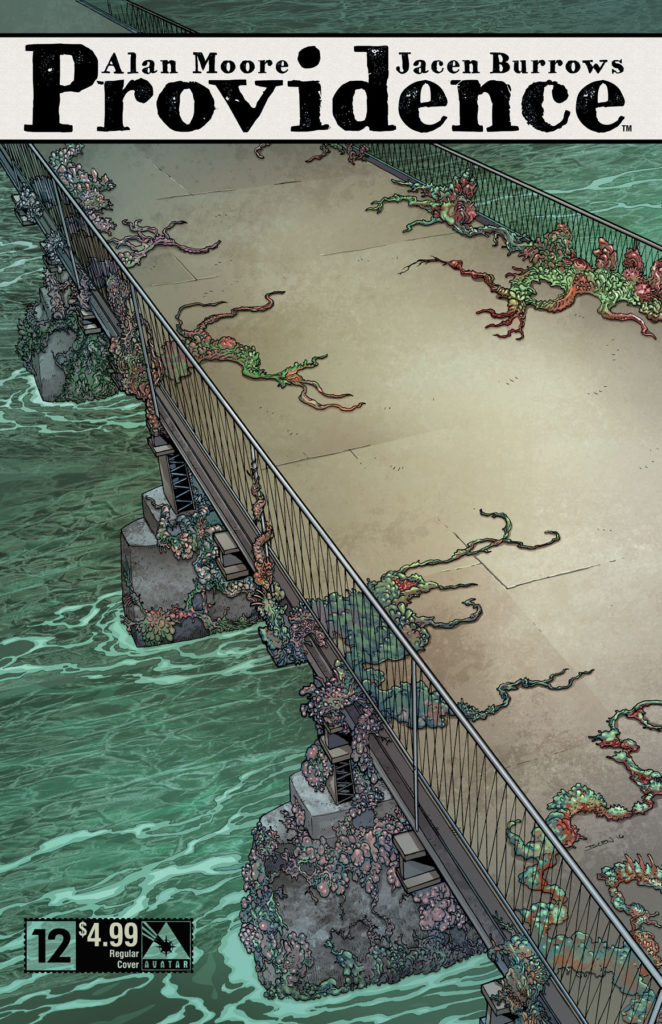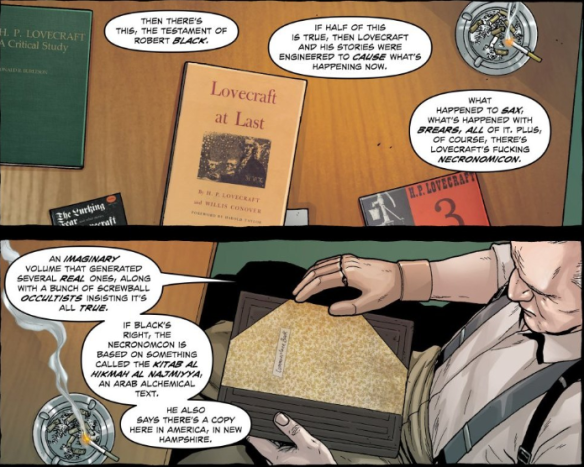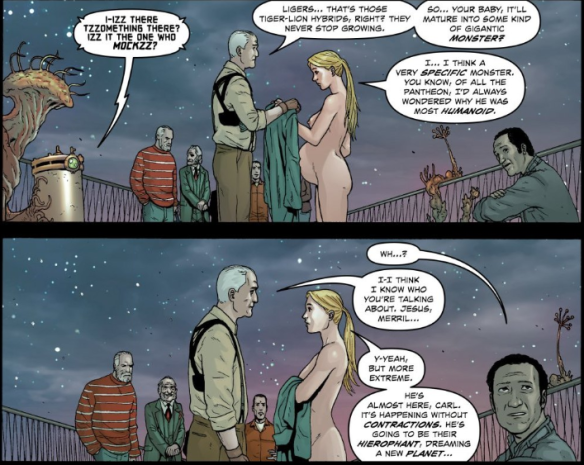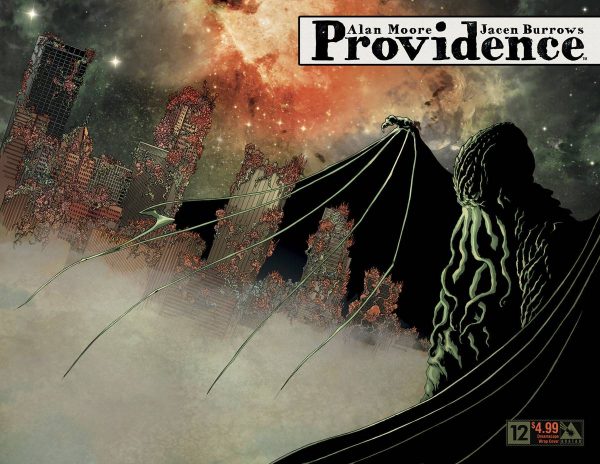
Apocalypse, big and small, has always been a central theme in Alan Moore’s work, going nearly all the way back: V For Vendetta was set in a post-apocalyptic world from the outset, but concluded with the un-making of the fascist society that had held sway since the bombs fell; Watchmen posited the still-hotly-debated question about whether or not Adrian Veidt was right to “save” the world by ending the world as we knew it; Miracleman blew up the world on a conceptual level by ushering in a morally and ethically ambiguous (at best) age of gods — it’s a constant through-line, even if you sometimes have to strain to see it.
Here’s the thing, though — in Moore’s eyes, apocalypse itself isn’t always such a bad thing. Promethea concluded with what might be called a “joyous apocalypse,” as the old ways of our thinking, co-existing with each other, and even being were gloriously swept aside in favor of something that can in a pinch be thought of as a sort of genuine, all-encompassing enlightenment, and in various interviews over the years Moore has spoken about the end of the world, or at least the world as we’ve constructed it, in almost hopeful terms — and this was well before notions as still-patently-ridiculous as that of “President Trump” had come to pass, so one is probably safe to assume that apocalypse would be a prospect he’d be positively giddy about now. Sadly, we appear far more likely to get armageddon instead, and however you slice it, chances are that’s really gonna suck. But I digress —

Given the author’s general “pro-apcalyptic” (as opposed to nihilist, there’s a world of difference) bent, it’s perhaps a bit surprising to see, then, that the end of the world as we know it as detailed in the pages of the twelfth and final issue of his and Jacen Burrows’ Providence is not something that’s going to leave us all, with apologies to R.E.M., “feeling fine.” Events, rapid-fire as they were, in the previous issue left left no doubt about where our story was ultimately headed, but to see it play out as predictably as it all does is perhaps the biggest surprise on offer here for long-terms Moore readers, who are accustomed to The Bearded One always having one more trick up his sleeve. This time out he doesn’t, but I would contend that actually fits right in with this series’ underlying sense of doom and inevitability in a way that a concluding segment that pulled out a couple of “shockeroo” moments never could. H.P. Lovecraft’s fictional (?) alternate reality of Yuggoth is upon us now, over-writing reality as we have come to understand it, but as is made abundantly clear by the no-less-momentous-for-their-predictability events of this chapter, it’s been here the whole time. As straight-ruled panels that used to denote dreams or other altered states of consciousness take over for the “hand-cut” panels that used to symbolize “reality,” we know that things have “flipped,” but we also know that what’s taking place has less to do with violent upheaval and much more to do with a pre-ordained transition. I can perhaps say no more without saying too much, but I will clue you in to this little tidbit: We’re a part of it, too. You and I as readers have our cleverly-engineered place in everything that’s going on here, and this “meta”-narrative has been sucking us in from the outset, inexorably, with our final destination of Leng waiting for us patiently the whole time.
Speaking of which — if there’s one fly in Providence #12’s ointment, it’s probably the fact that any folks reading this who haven’t read Moore and Burrows’ earlier Neonomicon are likely going to be left hopelessly behind by everything going on here. The story of Robert Black (whose destiny was, let’s not forget, foretold from jump) ended last time out, and the main order of business this time around is simply (and elegantly, and terrifyingly) making explicit what was implicit at the end of Neonomicon #4 lo, those many (or eight, by my count) years ago. FBI agent Merril Brears (whose, subjugation, oppression, and violation provides the strongest possible hint that this new reality will be no better than the old) is at the center at of all that’s happening in this issue, with sidekicks Barstow, Fuller, and director Carl Perlman in tow, but that doesn’t mean we’ve seen the last of a few characters introduced in the pages of this series, either. Increase Orne, for instance, is along for the ride, as is Shadrach Annesley (whose presence provides for the issue’s only — admittedly pitch-black — moments of levity), and as the world is un-made/re-made/re-set, there are some new attendants (many of historical renown) there to bear witness and/or act as commentators on the proceedings, as well, but make no mistake : this is more a capstone on the entire Moore/Burrows Lovecraft oeuvre than it is on the most recent (and longest) leg of it. Which is perhaps curious given that apparently the two are working on a short follow-up series to follow at some point here, but hey — if you’re of a frame of mind to tug at the harness of inevitability, you’re probably not going to find this issue to your liking, anyway. It is what it is and all that.

Despite the air of finality, though, questions most certainly do remain, so that promised follow-up maybe does make more sense than it would seem to at first. Johnny Carcosa, for his part, remains as enigmatic a figure as ever, and ties between the Catholic Church and the Stella Sapiente order are hinted at before being left intriguingly beyond the grasp of our understanding, so there’s fertile ground yet to be idea-farmed around these parts. I could insert a cheap quip referencing the “nothing ends, Adrian. Nothing ever ends” line at this point, I suppose, but you know what? Given the way DC has chosen to pick up on that one in the creatively-moribund Rebirth era, I think I’ll just leave it alone.
I’d be committing gross malpractice, though, if I didn’t take a moment to single out Jacen Burrows’ work on this issue for some richly-deserved praise. His art has largely been exemplary throughout this series, barring the occasional depth-perspective choices I’ve quibbled with in previous reviews, but he leaves it all on the page here and delivers a bravura performance of finely-detailed, expressive illustration that brings out both the emotion in his human characters and the dread inherent in their increasingly inhuman surroundings with a real sense of macabre wonder. While others have occasionally queried as to why Moore didn’t attempt to pair with a “superstar” artist on this project, this issue effectively puts such idle speculations to rest — I can’t think of anyone better suited to draw the sort of material that’s on offer here, and I sincerely hope that editors at higher-paying publishing houses have taken note of his growth and progression, because he’s firmly cemented his status as a “A-lister” with this all-stops-pulled-out effort.

Now, of course, comes many years of debate and discussion as to where Providence falls in the larger pantheon of Moore works. I’ll need to embark on a comprehensive first-issue-to-last re-read before I can firmly decide that for myself, but I think it’s safe to say that we can probably all agree that it is by no means yet another piece of “Minor Moore” as we’d been accustomed to with his Avatar-published projects, most of which had previously been faithful adaptations of sidebar items initially done for other media. This is big, bold, expansive, challenging (thematically and practically) stuff, the product of robust and bold imagining that rivals his most celebrated works in terms of its scope and magnitude. It hasn’t supplanted From Hell and Promethea at the top of my own personal “Favorite Alan Moore Books” list, but in time I could see it working its way into that conversation. As the “trade-waiters” jump on with the inevitable (there’s that word again) hardcover, deluxe hardcover, leatherbound, paperback (the list is sure to be endless) collections, we’ll see how they feel about it, but at the very least, I feel confident in predicting that most will be more than pleasantly surprised to find an ambitious Phoenix such as this rising from the ashes of Neonomicon, which generally (if, in my own humble view, inaccurately) remains its author’s most comprehensively-reviled work.
All of which, I suppose, is my way of saying that if these reviews of mine haven’t convinced you to give this thing a look, hopefully the collected edition(s) will. Providence is a dense, complex, multi-faceted, perspective-shaking undertaking whose stature is likely only to grow, Fungi of Yuggoth-like, over time. My respect and admiration for its creators is already well-established, to be sure, but beyond that, and for whatever it’s worth, they also have my profound and heartfelt thanks.
For more reading on the subject, please check out:
Tags: Alan Moore, Avatar Press, Comic Books, Comics, Horror, Jacen Burrows


No Comments